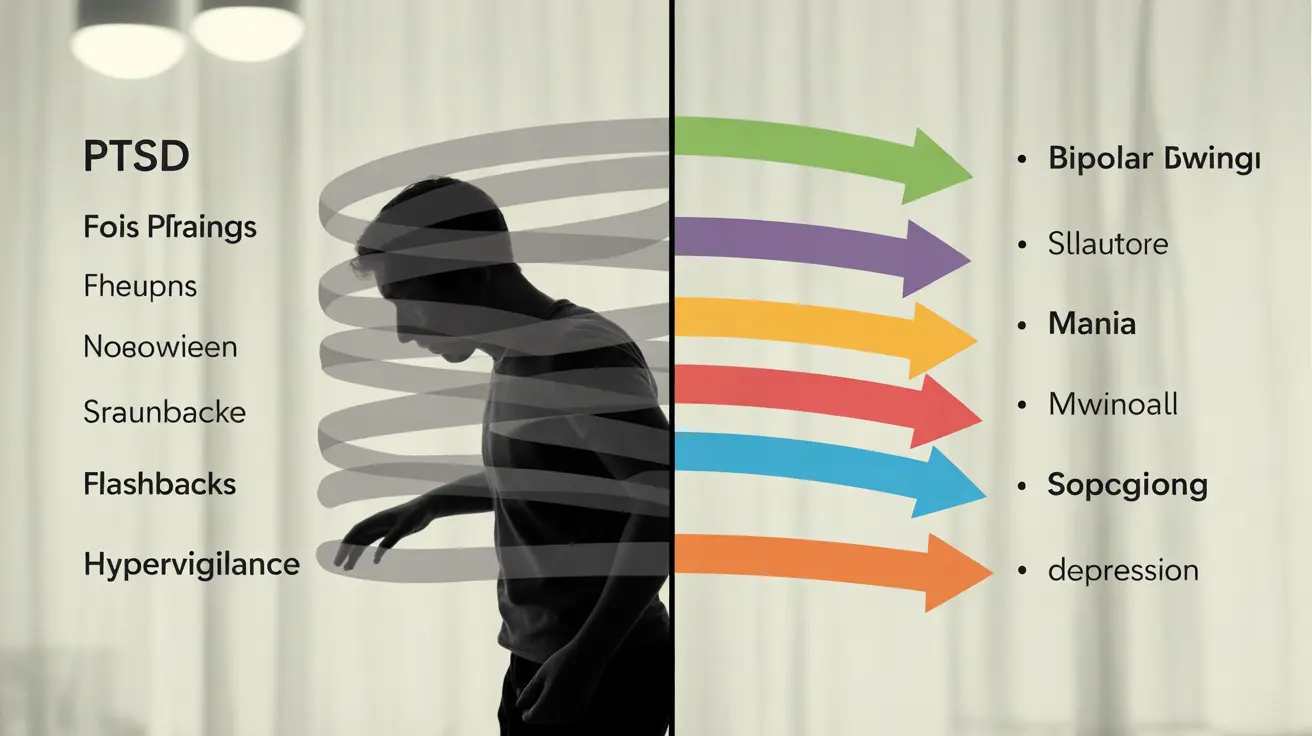Both Post-Traumatic Stress Disorder (PTSD) and bipolar disorder can significantly impact a person's emotional well-being and daily life, but they are distinct mental health conditions with different causes, symptoms, and treatment approaches. Understanding these differences is crucial for proper diagnosis and effective treatment.
In this comprehensive guide, we'll explore the key distinctions between PTSD and bipolar disorder, examining their unique characteristics, diagnostic criteria, and treatment options. This information will help you better understand these conditions and why accurate diagnosis is essential for effective care.
Understanding PTSD and Bipolar Disorder: Core Differences
While both conditions can affect mood and behavior, PTSD and bipolar disorder have fundamentally different origins and manifestations. PTSD is a trauma-response condition, while bipolar disorder is a mood disorder that involves distinct episodes of mania and depression.
PTSD: A Trauma-Based Response
PTSD develops specifically in response to experiencing or witnessing traumatic events. Key characteristics include:
- Intrusive memories or flashbacks
- Avoidance of trauma-related triggers
- Hypervigilance and heightened startle response
- Emotional numbness or detachment
- Sleep disturbances and nightmares
Bipolar Disorder: A Mood Regulation Condition
Bipolar disorder is characterized by significant mood swings that include both manic and depressive episodes. Primary features include:
- Periods of elevated mood (mania or hypomania)
- Episodes of severe depression
- Changes in energy levels and activity
- Sleep pattern disruptions
- Impulsive behavior during manic phases
Diagnostic Approaches and Challenges
Mental health professionals use specific criteria and assessment tools to differentiate between PTSD and bipolar disorder. The diagnostic process typically involves:
- Detailed patient history
- Symptom evaluation
- Assessment of triggering events
- Timeline analysis of mood changes
- Consideration of family history
Treatment Strategies and Management
PTSD Treatment Approaches
PTSD treatment typically focuses on trauma processing and coping strategies:
- Trauma-focused cognitive behavioral therapy
- Eye Movement Desensitization and Reprocessing (EMDR)
- Exposure therapy
- Anxiety management techniques
- Selective serotonin reuptake inhibitors (SSRIs)
Bipolar Disorder Management
Bipolar disorder treatment emphasizes mood stabilization and long-term management:
- Mood stabilizing medications
- Antipsychotic medications
- Psychotherapy
- Lifestyle modifications
- Regular sleep schedule maintenance
Frequently Asked Questions
- What are the main differences in symptoms between PTSD and bipolar disorder?
PTSD symptoms are directly linked to trauma and include flashbacks, avoidance behaviors, and hypervigilance. Bipolar disorder involves distinct episodes of mania and depression that aren't necessarily connected to specific events. PTSD symptoms are generally consistent, while bipolar symptoms cycle between extreme moods.
- How can a doctor tell if mood swings are caused by PTSD or bipolar disorder?
Doctors differentiate between these conditions by examining the pattern and triggers of mood changes. PTSD mood changes are typically triggered by trauma-related stimuli, while bipolar mood swings occur in cycles independent of external triggers. They also consider family history and the presence of specific symptoms unique to each condition.
- Can a person have both PTSD and bipolar disorder at the same time?
Yes, it's possible to have both conditions simultaneously, known as comorbidity. This situation requires carefully coordinated treatment approaches that address both conditions while avoiding potential interactions between different treatments.
- What treatments are effective for managing PTSD versus bipolar disorder?
PTSD treatments focus on trauma processing through therapies like EMDR and exposure therapy, along with SSRIs. Bipolar disorder primarily requires mood stabilizers and antipsychotic medications, combined with psychotherapy. Each condition needs its specific treatment approach, even when they co-occur.
- Why does PTSD develop after trauma, while bipolar disorder does not require a traumatic event?
PTSD is a direct response to trauma, developing when the brain's stress response system becomes dysregulated after a threatening event. Bipolar disorder, however, is believed to have a stronger genetic component and involves disruptions in brain chemistry that affect mood regulation, regardless of external events.




